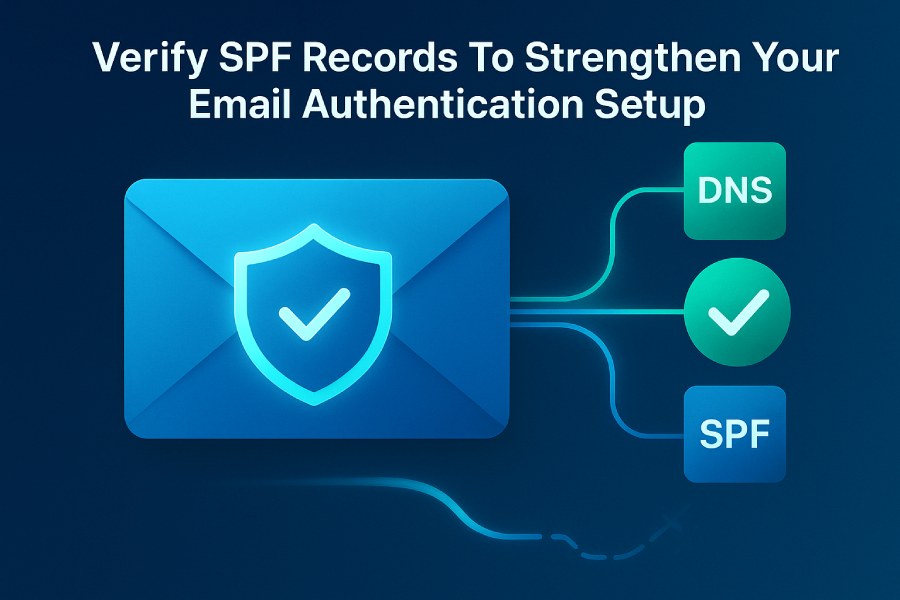Understanding SPF: What is Sender Policy Framework?
The Sender Policy Framework (SPF) is a pivotal protocol in the world of email authentication designed to enhance email security by mitigating email spoofing—a technique often leveraged in email phishing attacks. At its core, an SPF record is a specially formatted DNS TXT record published in the authoritative DNS zone file of an email domain that specifies which mail servers are authorized to send emails on behalf of that domain.
SPF works by enabling recipient mail servers to perform an email sender verification through a DNS lookup. This lookup confirms whether the IP address of the sending server—typically the SMTP server—matches those authorized within the sender domain’s SPF record. Without an SPF record, malicious actors can more easily forge emails, leading to increased risks of fraud, phishing, and email spoofing, tarnishing email trust and harming email deliverability.
Why SPF Records are Crucial for Email Authentication
Implementing an accurate and optimized SPF record is essential for effective domain authentication and maintaining strong phishing protection. In combination with other anti-spam standards like DKIM (DomainKeys Identified Mail) and DMARC (Domain-based Message Authentication, Reporting, and Conformance), SPF forms a triad that safeguards corporate and personal email communications.
SPF significantly contributes to:
- Email spam filtering: Email service providers such as Google Workspace, Office 365, and cloud security vendors like Cisco Talos or FireEye rely on SPF validation to proactively filter malicious emails.
- Preventing email spoofing: SPF reduces forgery attempts by verifying if the sending server’s IP address is authorized via IP address authorization listed in the SPF record.
- Improving email deliverability: Correct domain authentication by SPF ensures legitimate emails successfully reach the mail exchanger (MX) servers of receiving domains, avoiding rejection or placement in spam folders.
- Protecting against blacklists: Domains without properly configured SPF records are more prone to get listed on email blacklists, hindering email campaigns by platforms such as Mailchimp, SendGrid, and SparkPost.
Leading global technology companies, including Microsoft, Google, Amazon Web Services (AWS), and security vendors like Fortinet and Barracuda Networks, emphasize implementing SPF as part of comprehensive email security frameworks. Specialized tools like Valimail, DMARC Analyzer, and Agari further assist organizations in managing and validating SPF records to reinforce email sender policy and compliance.
How SPF Works: The Technical Basics
To understand SPF’s functionality, it is important to break down the process flow during an email transaction:
1. DNS TXT Record Configuration:
The domain owner defines an SPF record in their DNS zone file. This record explicitly enumerates authorized IP addresses, hostnames, and third-party email services permitted to send mail on behalf of their domain. This setup requires accurate DNS server configuration to ensure proper DNS propagation.
2. Email Sending and DNS Lookup:
When an email is sent, the recipient’s SMTP server extracts the sender’s domain from the email headers and queries the domain’s DNS for the SPF TXT record.
3. IP Address Authorization Check:
This lookup initiates a DNS lookup of the SPF record content, utilizing syntax components like the SPF include mechanism (to encompass third-party services such as Zoho Mail, Postmark, or Auth0), SPF redirect, and the SPF all mechanism that defines the default policy.

4. SPF Result Evaluation:
Based on the evaluation, the recipient server categorizes the outcome as one of the following SPF results:
- SPF pass: The sending IP is authorized.
- SPF fail: The IP address is unauthorized and the email should be rejected or flagged.
- SPF softfail: The IP is not authorized, but the policy indicates a gentle rejection, generally leading to increased scrutiny.
- SPF neutral: No definitive assertion on the IP’s status.
- SPF none: No SPF record was found for the domain.
5. Email Acceptance or Rejection:
The recipient’s system applies the domain’s SPF policy to decide on acceptance, rejection, or tagging, which contributes directly to the overall email spam filtering process.
This validation also complements reverse DNS lookups and can be paired with extensive email header analysis for profound insight into email provenance.
Common SPF Record Syntax and Terminology Explained
An effective SPF record balances complexity, length, and performance. The SPF syntax uses several mechanisms and qualifiers crucial for accurate domain authentication:
- v=spf1: This version tag signifies the start of an SPF record.
- ip4/ip6: Specifies authorized IPv4 or IPv6 addresses/networks.
- include: Incorporates SPF records of trusted third-party email services or cloud platforms like Cloudflare or Amazon Web Services.
- a: Authorizes IP addresses of A (address) records for the domain.
- mx: Permits mail exchangers (MX) configured to send emails.
- ptr: Rarely used, confirms the domain name matches reverse DNS entries.
- all: Often placed at the end; it directs the default SPF policy.
SPF record length and the SPF limit on DNS lookups (usually capped at 10) are critical considerations to avoid performance detriments. Exceeding this limit results in failure of SPF validation, which can be examined through reliable SPF record checkers and SPF validation tools from vendors like Mimecast and Ping Identity.
Beware of the common pitfall of publishing SPF multiple records for the same domain, which violates standards and leads to erroneous results. Instead, SPF record optimization strategies consolidate authorized senders into a single, maintainable record.
Risks of Misconfigured or Missing SPF Records
Failure to correctly configure SPF records or omitting them altogether exposes organizations to severe vulnerabilities and operational issues:
- Increased susceptibility to email spoofing and phishing: Cybercriminals exploit absent or faulty SPF records to impersonate a brand’s email domain, delivering fraudulent messages with malicious intent.
- Damage to email reputation and trust: Without domain authentication measures, enterprises risk landing on email blacklists, compromising their marketing and communication efforts.
- Complications in email server configuration: Maintaining compliance with industry anti-spam standards like DMARC and DKIM protocols. SPF acts as a complementary layer to these frameworks; thus, incomplete configurations weaken the entire authentication ecosystem.
- Email deliverability issues: Legitimate emails may be improperly flagged by filtering solutions from security providers such as Trend Micro, Symantec, McAfee, or Kaspersky Lab, negatively impacting business operations.
- Complex SPF troubleshooting: Resolving such issues requires in-depth analysis using SPF check online utilities and detailed examination of email headers to diagnose SPF pass, SPF neutral, or SPF softfail cases.
Experts at The Electronic Frontier Foundation (EFF) and industry-leading technology companies advocate for regular SPF SPF update and monitoring, particularly when adding or changing third-party email services or cloud providers to maintain the integrity of your email sender policy.

By thoroughly understanding the technical principles behind SPF, its syntax, and the critical need for proper configuration, organizations can significantly enhance their domain authentication infrastructure, thereby fortifying their defenses against email phishing attacks and fostering robust email trust among recipients worldwide.
Tools and Methods to Verify Your SPF Records
Ensuring the integrity of your SPF record is pivotal in the domain authentication chain that bolsters email security and protects against email spoofing and phishing attacks. Various SPF validation tools exist to assist administrators, security teams, and email service providers in verifying and analyzing SPF DNS TXT records effectively.
Popular SPF record checkers such as those offered by DMARC Analyzer, Valimail, and Agari provide user-friendly interfaces for performing SPF checks online. These tools execute a DNS lookup of the SPF TXT record, perform email sender verification by simulating SMTP server queries, and analyze the SPF syntax to flag issues like SPF multiple records or incorrect SPF all mechanism usage.
Security vendors like Cisco Talos, Proofpoint, and Barracuda Networks integrate SPF validation into their comprehensive email spam filtering and anti-spam standards platforms to provide automated SPF fail/pass assessments during email header analysis. These checks supplement reverse DNS and DKIM evaluations to produce a complete picture of the email’s trustworthiness and deliverability potential.
DNS server configuration and propagation delays are other important factors to consider when verifying SPF records, especially after SPF updates. Tools such as Cloudflare’s DNS lookup utility and Dyn (Oracle) DNS testing suites assist in ensuring SPF changes have properly propagated within DNS zone files.
Interpreting SPF Record Test Results and Troubleshooting
SPF validation tools and email server logs generate detailed results that require understanding the nuances of SPF authorization:
- SPF Pass: Indicates that the connecting SMTP server’s IP address is authorized in the DNS TXT record, confirming proper domain authentication for the sending email domain.
- SPF Fail: Denotes that the IP address is not listed in the SPF record, signaling potential unauthorized sender attempts or email spoofing attacks.
- SPF Softfail: A warning state, often configured with the `~all` mechanism, suggesting caution but not outright rejection—useful for gradual policy adoption.
- SPF Neutral: This outcome signals that the SPF policy neither authorizes nor denies the sender, which can reduce email deliverability due to uncertainty.
Common issues can include SPF multiple records for a domain, which violates RFC guidelines and causes SPF validation failures. Administrators should ensure only one SPF DNS TXT record exists and consolidate entries if multiple are found.
SPF troubleshooting also involves addressing SPF record length concerns, minimizing DNS lookups for optimal email deliverability. Tools from Ping Identity and Auth0 often include optimization features that flatten nested SPF includes to reduce lookup counts and improve performance.
Best Practices for Creating and Managing SPF Records
- Use a Single, Well-Formatted SPF Record: Ensure there is exactly one SPF DNS TXT record per email domain. Avoid duplicate records in the DNS zone file to comply with standards and prevent SPF fail outcomes.
- Leverage the SPF Include Mechanism: When authorizing third-party email services like Mailchimp, Zoho Mail, or Office 365, use the `include:` modifier rather than hard-coded IPs to delegate authorization, facilitating SPF record updates and DSP propagation.
- Monitor DNS Lookup Count and Use SPF Redirect: Maintain SPF lookup counts below the 10-limit threshold by using SPF redirect policies where appropriate.
- Regular SPF Record Updates: Periodically audit and update SPF records to reflect changes in mail servers, third-party IP ranges, or new service providers.
- Implement Reverse DNS: Configure reverse DNS pointers for SMTP servers to strengthen email sender verification as part of holistic email security.
- Coordinate with Email Server Configuration: Align SPF policies with the SMTP server settings and MX records to maximize email deliverability and reduce false positives in spam filtering.

Combining SPF with DKIM and DMARC for Enhanced Security
While SPF is a critical mechanism for email sender verification and phishing protection, combining it with DKIM (DomainKeys Identified Mail) and DMARC (Domain-based Message Authentication, Reporting & Conformance) forms a comprehensive defense against email phishing attacks.
- DKIM introduces cryptographic signatures to email headers, enabling tamper-proof email header analysis.
- DMARC leverages SPF and DKIM results to define a domain’s policy on how to handle authentication failures and provides reporting mechanisms for actionable intelligence on email spoofing attempts.
Microsoft’s Office 365, Google’s Google Workspace, and platforms like Mimecast and Proofpoint have incorporated integrated dashboards that help organizations manage and correlate SPF, DKIM, and DMARC records to maximize email trust, enhance phishing protection, and maintain high email deliverability.
How to Address SPF Record Flattening and Lookup Limits
SPF record flattening is a strategy deployed to meet the SPF limit requirements imposed by the Sender Policy Framework—a maximum of 10 DNS lookups per SPF evaluation. Complex SPF records integrating multiple third-party email services can easily exceed this threshold.
- Flatten the SPF Record: This involves replacing the `include` mechanisms and nested redirects with a concise list of authorized IP addresses, reducing DNS lookups and the risk of SPF softfail or fail during SPF validation.
- Utilize SPF Record Optimization Services: Companies like Valimail and Agari offer SPF record optimization tools that help balance readability, maintainability, and compliance with SPF limits without sacrificing security.
- Regularly Review and Update Authorized IPs: As your organization adds or removes third-party email providers such as SendGrid or SparkPost, adjust your SPF record to minimize unnecessary lookups.
- Monitor SPF Record Length: Excessively long DNS TXT records can cause parsing errors and delay DNS propagation, so maintain a streamlined DNS zone file.
By employing these measures and monitoring outputs from SPF validation tools and SPF record checkers, security teams ensure compliant Sender Policy Framework policies that protect the email domain from abuse while maintaining robust email deliverability.
Incorporating these procedures and insights coupled with tools from industry leaders like Microsoft, Google, Cloudflare, and IBM Security helps organizations maintain effective email sender policies that adhere to evolving anti-spam standards and phishing protection requirements.
Case Studies: Successful Email Authentication Through SPF Verification
Numerous organizations have leveraged the Sender Policy Framework (SPF) to enhance their email authentication and bolster phishing protection effectively. A prominent example is Microsoft, which integrates SPF as a core part of its email security protocols within Office 365. By maintaining an optimized SPF record within their DNS zone file, including IP address authorization for their SMTP servers, Microsoft has significantly reduced instances of email spoofing across their domain. This has been complemented with DKIM and DMARC policies to provide layered domain authentication, improving email header analysis to detect fraudulent messages.

Similarly, Google Workspace employs SPF validation tools alongside DKIM and DMARC to verify email senders accurately. Google’s approach utilizes SPF include mechanism, accounting for third-party email services such as SendGrid and Mailchimp, ensuring that all authorized IPs are listed correctly in their DNS TXT record. SPF pass rates increased notably following SPF record optimization, minimizing SPF fail or SPF softfail results observed during DNS lookups. The result has been an appreciable improvement in email spam filtering and email sender verification, leading to enhanced email deliverability and user trust.
Organizations like Amazon Web Services (AWS) also provide detailed SPF records for their SES (Simple Email Service), helping customers configure proper SPF syntax and SPF policies. This enables seamless domain authentication while mitigating risks related to SPF multiple records and SPF record length, often a challenge in complex DNS server configurations. Third-party solutions from vendors such as Proofpoint and Barracuda Networks facilitate SPF troubleshooting with specialized SPF record checkers, guiding enterprises to maintain accurate SPF records and robust email sender policies.
Impact of SPF Verification on Email Deliverability and Spam Reduction
Implementing a correct and optimized SPF record significantly impacts email deliverability. Email service providers (ESPs) and anti-spam standards increasingly rely on SPF as a critical checkpoint in email sender verification. When an email passes SPF validation (SPF pass), it signals trustworthy domain authentication and IP address authorization to the receiving SMTP server, improving email deliverability rates.
Conversely, emails with SPF fail or SPF softfail results are more likely to be flagged by email spam filtering engines or routed to junk folders, reducing the risk of spoofed messages reaching end users. Important mail exchanger (MX) servers performing DNS lookups use the SPF record within DNS TXT records to evaluate legitimacy. This process complements reverse DNS checks and DKIM/DMARC policies, creating a comprehensive defense against email phishing attacks.
An SPF neutral result often indicates incomplete or overly permissive SPF syntax, which does not contribute effectively to email security. Maintaining SPF record optimization—such as avoiding SPF multiple records per domain and managing SPF record length and SPF limit constraints—helps reduce SPF neutral or ambiguous outcomes. Enhanced email deliverability is especially critical for organizations relying on third-party email services like SparkPost, Postmark, or Zoho Mail, where inadequate SPF records can lead to blocking or blacklisting by advanced spam filters operated by Cisco Talos, Trend Micro, or Symantec.
Automating SPF Record Monitoring and Verification
Given the complexity of SPF management, automation plays a vital role in maintaining effective email sender policies. Tools developed by companies such as Valimail, DMARC Analyzer, and Agari automate SPF record monitoring and SPF verification processes, ensuring continuous compliance with SPF syntax best practices and SPF policy requirements.
Automation platforms regularly perform DNS lookups on the DNS TXT record, tracking DNS propagation and triggering alerts when discrepancies or outdated SPF records are detected. This proactive approach enhances email security by preventing inadvertent SPF fail scenarios stemming from misconfigured DNS zone files or changes in IP address authorization, especially when organizations engage multiple third-party email services.
SPF record checkers and SPF validation tools available online allow IT administrators and email security teams to conduct email header analysis and SPF troubleshooting in real time. These tools help identify and reconcile SPF redirects, evaluate the proper use of the SPF include mechanism, and assess SPF all mechanism placement in the SPF policy. Automated monitoring reduces reliance on manual DNS server configuration and minimizes errors during SPF updates, safeguarding against email spoofing and phishing attacks.






